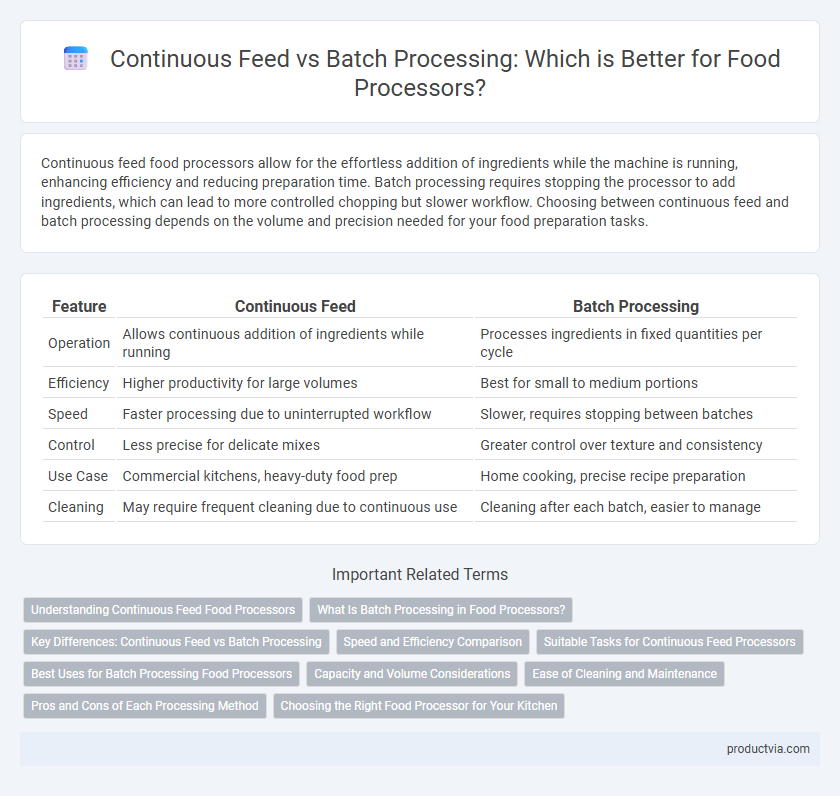Continuous feed food processors allow for the effortless addition of ingredients while the machine is running, enhancing efficiency and reducing preparation time. Batch processing requires stopping the processor to add ingredients, which can lead to more controlled chopping but slower workflow. Choosing between continuous feed and batch processing depends on the volume and precision needed for your food preparation tasks.
Table of Comparison
| Feature | Continuous Feed | Batch Processing |
|---|---|---|
| Operation | Allows continuous addition of ingredients while running | Processes ingredients in fixed quantities per cycle |
| Efficiency | Higher productivity for large volumes | Best for small to medium portions |
| Speed | Faster processing due to uninterrupted workflow | Slower, requires stopping between batches |
| Control | Less precise for delicate mixes | Greater control over texture and consistency |
| Use Case | Commercial kitchens, heavy-duty food prep | Home cooking, precise recipe preparation |
| Cleaning | May require frequent cleaning due to continuous use | Cleaning after each batch, easier to manage |
Understanding Continuous Feed Food Processors
Continuous feed food processors offer a streamlined approach by allowing ingredients to be added gradually through a feed tube while the machine operates, enhancing efficiency for large-volume food preparation. These processors typically feature a wide feed chute and robust motor power, facilitating faster processing of whole vegetables or fruits without pre-cutting. Continuous feed models excel in tasks like shredding, slicing, and chopping with minimal interruption, making them ideal for busy kitchens and extensive meal prep.
What Is Batch Processing in Food Processors?
Batch processing in food processors involves adding ingredients in separated portions and processing them in distinct cycles, offering precise control over texture and consistency. This method is ideal for recipes requiring uniform chopping, mixing, or pureeing of small quantities, ensuring each batch meets exact culinary standards. Batch processing also allows for customization in speed and processing time, making it suitable for delicate ingredients that need gentle handling.
Key Differences: Continuous Feed vs Batch Processing
Continuous feed food processors allow for nonstop ingredient input and processing, ideal for large-volume tasks and seamless workflow in busy kitchens. Batch processing requires chopping or mixing ingredients in smaller, separate portions, offering more control over texture and consistency but less efficiency for high-capacity jobs. Key differences include processing speed, volume capacity, and control over ingredient handling, with continuous feed maximizing throughput and batch processing emphasizing precision.
Speed and Efficiency Comparison
Continuous feed food processors excel in speed and efficiency by allowing ingredients to be added without stopping the machine, ideal for high-volume tasks. Batch processing requires pausing to add ingredients, which can reduce overall throughput and increase preparation time. For kitchens prioritizing rapid processing and uninterrupted workflow, continuous feed models offer significant advantages over batch processors.
Suitable Tasks for Continuous Feed Processors
Continuous feed food processors excel in handling large quantities of ingredients efficiently, making them ideal for slicing, shredding, and grating vegetables and cheese during meal prep. Their design allows for uninterrupted processing, which is especially suitable for tasks requiring speed and consistency, such as preparing salads or coleslaws in bulk. These processors are preferred in commercial kitchens and households that demand rapid, high-volume food preparation without frequent stops to reload.
Best Uses for Batch Processing Food Processors
Batch processing food processors excel in tasks requiring precise control and multiple ingredient additions, such as kneading dough or chopping nuts and herbs. They are ideal for recipes that involve intermittent processing, allowing users to manage texture and consistency more accurately. These processors are best suited for small to medium batches, making them perfect for home cooks focused on quality over quantity.
Capacity and Volume Considerations
Continuous feed food processors excel in handling large volumes of ingredients quickly due to their wide feed chutes, allowing for uninterrupted processing of whole items. Batch processing models require smaller amounts to be added in increments, making them ideal for precise control but limiting overall capacity and increasing preparation time. When selecting between the two, consider the volume of food typically processed, with continuous feed options better suited for high-capacity needs and batch processors for lower-volume, detail-oriented tasks.
Ease of Cleaning and Maintenance
Continuous feed food processors often feature detachable parts designed for quick disassembly, simplifying cleaning and maintenance. Batch processing models typically require more manual effort due to smaller bowls and fixed components that can trap food particles. Choosing a unit with dishwasher-safe parts and smooth surfaces significantly reduces cleaning time and upkeep.
Pros and Cons of Each Processing Method
Continuous feed food processors offer the advantage of processing large quantities rapidly, making them ideal for heavy-duty tasks and commercial use, but they may sacrifice precision and result consistency. Batch processing provides greater control and uniformity for individual tasks, allowing for customized ingredient handling, though it requires more time and frequent stopping to reload. Choosing between continuous feed and batch processing depends on balancing the need for speed and volume against precision and consistency in food preparation.
Choosing the Right Food Processor for Your Kitchen
Continuous feed food processors allow you to add ingredients while the machine is running, making them ideal for multitasking and quick meal preparation. Batch processing food processors require you to stop and add ingredients in separate steps, offering more control for precision tasks and smaller quantities. Selecting the right food processor depends on your cooking style, kitchen space, and the types of recipes you frequently prepare.
Continuous feed vs Batch processing for Food processor Infographic

 productvia.com
productvia.com